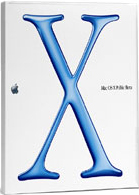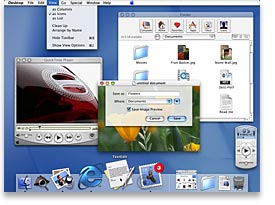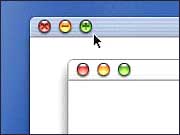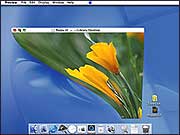
sponsored by
 sponsored by |
 | OSdata.com |

See also: Macintosh, Rhapsody, Mac OS X Server, and NeXT
Macintosh OS X (ten) is a desktop operating system based on Rhapsody. Macintosh OS X is made by Apple Computer and will run on Motorola/IBM PowerPC.
OSdata.com is used in more than 300 colleges and universities around the worldFind out how to get similar high web traffic and search engine placement. |
Macintosh OS X is essentially Rhapsody 3.0 optimized for Apple’s PowerPC computers, a high powered UNIX† with the friendly face of the Macintosh.
“Mac OS X is the most important software from Apple since the original Macintosh operating system in 1984 that revolutionized the entire industry. We can’t wait for Mac users around the globe to experience its stability, power and elegance.” —Steve Jobs, Apple’s CEO
“Forget a dual operating system strategy. In his keynote address at Apple’s 1998 Worldwide Developer Conference, Steve Jobs, Apple’s interim CEO, says all the company’s operating system plans are converging into one entity: Mac OS X (10), due next year [it actually arrived three years later].
“Mac OS 8 and Rhapsody will be the “parents” of Mac OS X, due the third quarter of 1999. The best parts of Rhapsody will be integrated into the Mac OS to make it a modern operating system. [NOTE: These dates slipped to first quarter 2001.]
“Mac OS X will be targeted for G3 systems and their predecessors; all shipping products will run Mac OS X. It will be 100% PowerPC native; all 68k code will be excised. The upcoming OS is slated to have protected memory, enhanced virtual memory (with no more fixed size heaps), preemptive multitasking, fast networking, and fast file I/O. It will also run Mac OS 8 compatible applications transparently [it ended up running Mac OS 9 applications that were updated to Carbon and didn’t involve access to hardware].” —Dennis Sellers, “The X-Files: Rhapsody, Allegro + Sonata = Mac OS 10”e30
“Mac OS X the biggest leap in the Mac OS since 1984, bringing it into new territory, but bringing all of us and current applications with it.” —Steve Jobse30
Intended purpose
server/mainframe: small to medium scale servers
desktop/workstation: general desktop and content creation workstations
handheld: not appropriate
real time: not appropriate

Kind of OS: proprietary BSD (Berkeley Software Distribution) UNIX†
“Under the appealing, easy-to-use interface is a rock-solid foundation — an industrial-strength core OS engineered for stability, reliability, and phenomenal performance.” — Apple Computerw56
![]() Much of the underpinnings of Mac OS X (MACH, FreeBSD, etc.) are open source projects.
Much of the underpinnings of Mac OS X (MACH, FreeBSD, etc.) are open source projects.
“The open source community helped bring you the core OS. Feel free to pitch in and contribute your programming talents.” — Apple Computerw56
“After protests that Apple was illegally violating the open source requirement to make available their enhancements, Apple finally released those underpinnings as Darwin, while continueing to keep higher level components a proprietary secret (and compounding their lack of ethics by falsely claiming that they were making their operating system open source while only making a small part open source) and simultaneously releasing the open source portions with a highly restrictive license that includes the option for Apple to revoke permission to use the code at any time at any whim, going against the very meaning of open source.” —a developer who requested his name be kept private
Public Beta Release Date: Sept 13, 2000
Official Release Date: March 24, 2001
Current Version: X (10.1.2)
Cost: $129
Mac OS X ships with 7 languages (English, Japanese, French, German, Spanish, Italian, and Dutch) included on a single CD.
Hardware Supported: IBM/Motorola PowerPC G3 and G4
Maximum Number of Processors: 32e125
Kernel: MACHe75 (microkernel)
“I expect there’s some work to port a Unix app to MacOS X, especially one that uses any of the Unix System-V APIs. BSD-flavored apps should port easily to MacOS X. Of course, the windowing systems of Unix and MacOS X are completely different, so don’t expect to easily port any X-windows apps.” — Steve Byane59
“Despite Mac OS X’s relative immaturity, it’s often more reliable at connecting to new add-ons [than Windows XP].” —Jim Heid, “A Study in Contrasts”, Los Angeles Times, March 2002n4
“I just got 10.1, and WOW. I knew I was going to get a lot more speed, but GEEZ! My PBG4/500 FLIES now. DVD playback was almost flawless in 9.x (unless you were running a lot of apps in the background). It *IS* flawless in 10.1. I was watching it full screen in the background while using AOL Instant Messenger (which munches processor cycles like a Pentium eats electricity), and it was PERFECT.” — Kynan Shook
Other Systems Emulated: MS-DOS (with third party Virtual PC), Windows 3.1 (with third party Virtual PC), Windows 95 (with third party Virtual PC or SoftWindows95), Windows 98 (with third party Virtual PC or SoftWindows98)
Graphics Engine: Quartz (formerly called Enhanced QuickDraw); OpenGL for 3D graphics

“Based on the portable document format (PDF), Quartz delivers on-the-fly rendering, anti-aliasing, and compositing of PostScript-strength graphics.” — Apple Computerw56
“It would certainly be nice if Apple Computer ever got some documentation out to developers on Quartz. So far, nothing is available. The WWDC session totally lacked any detail, much less having things like an API. They just point you to the Postscript and PDF specs, on which it is based. (Quartz is somewhat modified from these.) That still doesn’t qualify as an API or programmer-useful documentation. This is probably the area of Mac OSX where the developer need is the greatest and the information the least forthcoming. (If you can’t draw, you can’t do anything.)”
Text Command Shell: UNIX shells (default shell is tcsh, ships with precompiled copies of sh, csh, tcsh, and zsh)

User Interface (graphic): Aqua (built on the Macintosh ToolBox)
“The Aqua interface brings your Mac to life with color, depth, translucence, and fluid motion — and keeps you on top of things with continuous visual feedback.” — Apple Computerw56
“Aqua is what Eazel, Gnome, KDE, and all the rest of the we-make-it-easy Linux GUI crowd can only dream about. I find Aqua’s design light-years ahead of any other GUI on the market, which goes for both Linux and MS Windows.” —“X a perfect X”, Open (a Linux e-business magazine)m4
Graphic Command Shell: Finder

“With Mac OS X featuring numerous advances, it’s the job of the new Finder to ease your transition to the next level of computing. Navigating your Mac and the Internet has never been easier.” —Apple Computerw56
 |
 |
|
| controls in window title bar | a window opening |
blind: keyboard can be used to access the menu bar, the dock, palettes, toolbars, and window controls
deaf: system alert sound can be replaced by having the menu bar flash
motor impaired: Sticky Keys (a system wide control panel), Mouse Keys (a system wide control panel), keyboard can be used to access the menu bar, the dock, palettes, toolbars, and window controls

“Mac OS X combines a host of powerful features and technologies — plus iTools, Sherlock, and QuickTime TV — to give you more of what you want from the Internet.” — Apple Computerw56
“The killer app of the Internet gets compelling new features and capabilities. It’s called Mail, and it’s a full-featured email application built from the ground up as an integral part of Mac OS X.” — Apple Computerw56

“ ‘Mac OS X is going to be one of the best platforms for doing Web development,’ said Macromedia’s Tony Campitelli during Steve Jobs’ Seybold keynote.” — Apple Computerw56
http://www.isc.org/products/DHCP “Internet Software Consortium DHCP Server, Client, and Relay agent” freely redistributable tools: source builds on most Unix platforms, Mac, NeXTStep, and Rhapsody.
Bundled Software: iMovie™ 2 (low end digital video editing software); iTunes (low end consumer jukebox software for managing music files); most of the open source UNIX tools needed for commercial server operation
Other:
“From the WWDC98 charts, Mac OS X ’s CoreOS is essentially a Mach system kernel (mk7.x + other advancements) with a POSIX-like system interface very similar to *BSD-lite servers (which includes sockets), IOKit, VFS file system interface (a BSD 4.4 thing), and AppleTalk.” —Tuan Truonge49
“Macs have many advantages: ease of use, integration of OS and hardware, reliability, overall lower cost of ownership over the life of the machine, and, of course, style.” —Why Monopolies Are Bad, by Jeff Adkinsw77
![]()
(for your convenience, look for this symbol ![]() marking passages about Macintosh OS X)
marking passages about Macintosh OS X)
Please send recommendations on additional URLs to Milo.
(Frequently Asked Questions)
http://cynjut.neonramp.com/FAQ.html “The *BSD FAQ (Frequently Asked Questions)”
http://www.macinstruct.com/tutorials/macosx/index.shtml “Introduction to Mac OS X”
http://www.isc.org/products/DHCP “Internet Software Consortium DHCP Server, Client, and Relay agent” freely redistributable tools: source builds on most Unix platforms, Mac, NeXTStep, and Rhapsody.
http://www.unix-vs-nt.org/ John Kirch’s article “Microsoft Windows NT Server 4.0 versus UNIX”
For more UNIX book listings, see also the general book listings on the UNIX web page.
Also see the web pages for Rhapsody, NeXT, Mac OS X Server, and Macintosh.
If you want your book reviewed, please send a copy to: Milo, POB 1361, Tustin, CA 92781, USA.
Price listings are for courtesy purposes only and may be changed by the referenced businesses at any time without notice.
A Practical Guide to the Unix System; by Mark G. Sobell; Addison-Wesley Pub Co; October 1994; ISBN 0805375651; paperback; 800 pages; $37.95
Essential System Administration: Help for Unix System Administrators (Nutshell Handbook); 2nd edition; by Aeleen Frisch; O’Reilly & Associates; December 1996; ISBN 1565921275; paperback; 788 pages; $27.96
The Complete Guide to Netware 4.11/Intranetware; 2nd edition; by James E. Gaskin; Sybex; December 1996; ISBN 078211931X; paperback; $47.99; includes information on getting NetWare working with Windows, Macintosh, UNIX, and OS/2
Building a Unix Internet Server; by George Eckel; New Riders Publishing; June 1995; ISBN 1562054945; paperback (with CD-ROM); 325 pages; $30.40
Learn HTML 3.0 on the Macintosh; by Dave Mark, David Lawrence; Addison-Wesley Pub Co; July 1996; ISBN 0201887932; paperback; $29.95
Learn Java on the MacIntosh; by Barry Boone, Dave Mark; Addison-Wesley Pub Co; August 1996; ISBN 0201191571; paperback (with CD-ROM); 475 pages; $27.96
OPENSTEP for Enterprises; by Nancy Knolle Craighill; John Wiley & Sons; October 1996; ISBN 0471308595; 245 pages; $27.96
Developing Business Applications With OPENSTEP: With 37 Illustrations; by Peter Clark, Nik Gervae; Springer Verlag; December 1996; ISBN 038794852X; Paperback; 275 pages; $43.95
Beyond the Mac Is Not a Typewriter: More Typographic Insights and Secrets; by Robin Williams; Peachpit Press; January 1996; ISBN 0201885980; paperback; 222 pages; $13.56
Learn HTML 3.0 on the Macintosh; by Dave Mark, David Lawrence; Addison-Wesley Pub Co; July 1996; ISBN 0201887932; paperback; $29.95
The Multimedia Production Handbook for the PC, Macintosh, and Amiga; by Tom Yager; Academic Press Professional; December 1993; ISBN 0127680306; Paperback; 382 pages; $31.96
Learn Java on the MacIntosh; by Barry Boone, Dave Mark; Addison-Wesley Pub Co; August 1996; ISBN 0201191571; paperback (with CD-ROM); 475 pages; $27.96
Rhapsody Developer’s Guide: Developer’s Guide; by Jesse Feiler; AP Professional; August 1997; ISBN 0122513347; Paperback; $31.96
Developing Business Applications With OPENSTEP: With 37 Illustrations; by Peter Clark, Nik Gervae; Springer Verlag; December 1996; ISBN 038794852X; Paperback; 275 pages; $43.95
Black Art of Macintosh Game Programming; by Kevin Tieskoetter; Waite Group Pr; March 1996; ISBN 157169059X; paperback (with CD-ROM); $39.99
Learn Java on the MacIntosh; by Barry Boone, Dave Mark; Addison-Wesley Pub Co; August 1996; ISBN 0201191571; paperback (with CD-ROM); 475 pages; $27.96
Learn C on the MacIntosh; 2nd edition; by Dave Mark; Addison-Wesley Pub Co; October 1995; ISBN 0201484064; paperback (with CD-ROM); 474 pages; $27.96
Foundations of Mac Programming; by Dan P. Sydow; IDG Books Worldwide Inc.; December 20, 1995; ISBN 1568843496; paperback; 708 pages; $31.99
Advanced Programming in the Unix Environment (Addison-Wesley Professional Computing Series); by W. Richard Stevens; Addison-Wesley Pub Co; June 1992; ISBN 0201563177; hardcover; 744 pages; $63.95
C++ Programming With Codewarrior: For the Macintosh and Power Macintosh Beginner; by Jan L. Harrington; AP Professional; September 1995; ISBN 0123264200; paperback (with CD-ROM); 373 pages; $29.60
Metrowerks Codewarrior Programming; by Dan Parks Sydow; IDG Books Worldwide; December 1996; ISBN 1558515054; paperback; 538 pages (with CD-ROM); $31.96
Codewarrior Software Development Using Powerplant; by Jan L. Harrington; AP Professional; May 1996; ISBN 0123264227; paperback (with CD-ROM); 295 pages; $24.47
![]()
If you want your book reviewed, please send a copy to: Milo, POB 1361, Tustin, CA 92781, USA.
Also see the summary at Macintosh.

1.1 MB QuickTime movie of Bill Gates explaining why he thinks the Macintosh is the best operating system.
OSdata.com is used in more than 300 colleges and universities around the world |
| Tweets by @osdata |
A web site on dozens of operating systems simply can’t be maintained by one person. This is a cooperative effort. If you spot an error in fact, grammar, syntax, or spelling, or a broken link, or have additional information, commentary, or constructive criticism, please e-mail Milo. If you have any extra copies of docs, manuals, or other materials that can assist in accuracy and completeness, please send them to Milo, PO Box 1361, Tustin, CA, USA, 92781.
If you have an extra or unwanted copy of any official manuals or documentation on this operating system, please send them to: Milo, POB 1361, Tustin, CA 92781, USA. I have the following items: NONE.
Note: I am looking for a fan of Mac OS X who has the time to check this web site for completeness and accuracy regarding Mac OS X. Just check through the site about once a week or so and report back with any information (including the URL of the web page you are reporting).
![]()
Click here for our privacy policy.
Click here to skip over the summaries of individual operating systems.
| previous page | next page |
Digital UNIX (or DUNIX) |
||
|
||
|
||
![]()
This web site handcrafted on Macintosh ![]() computers using Tom Bender’s Tex-Edit Plus
computers using Tom Bender’s Tex-Edit Plus ![]() and served using FreeBSD
and served using FreeBSD ![]() .
.
†UNIX used as a generic term unless specifically used as a trademark (such as in the phrase “UNIX certified”). UNIX is a registered trademark in the United States and other countries, licensed exclusively through X/Open Company Ltd.
Names and logos of various OSs are trademarks of their respective owners.
Copyright © 1998, 1999, 2000, 2001, 2002 Milo
Last Updated: March 20, 2002
Created: June 22, 1998
Click here to skip over the summaries of individual operating systems.
| previous page | next page |